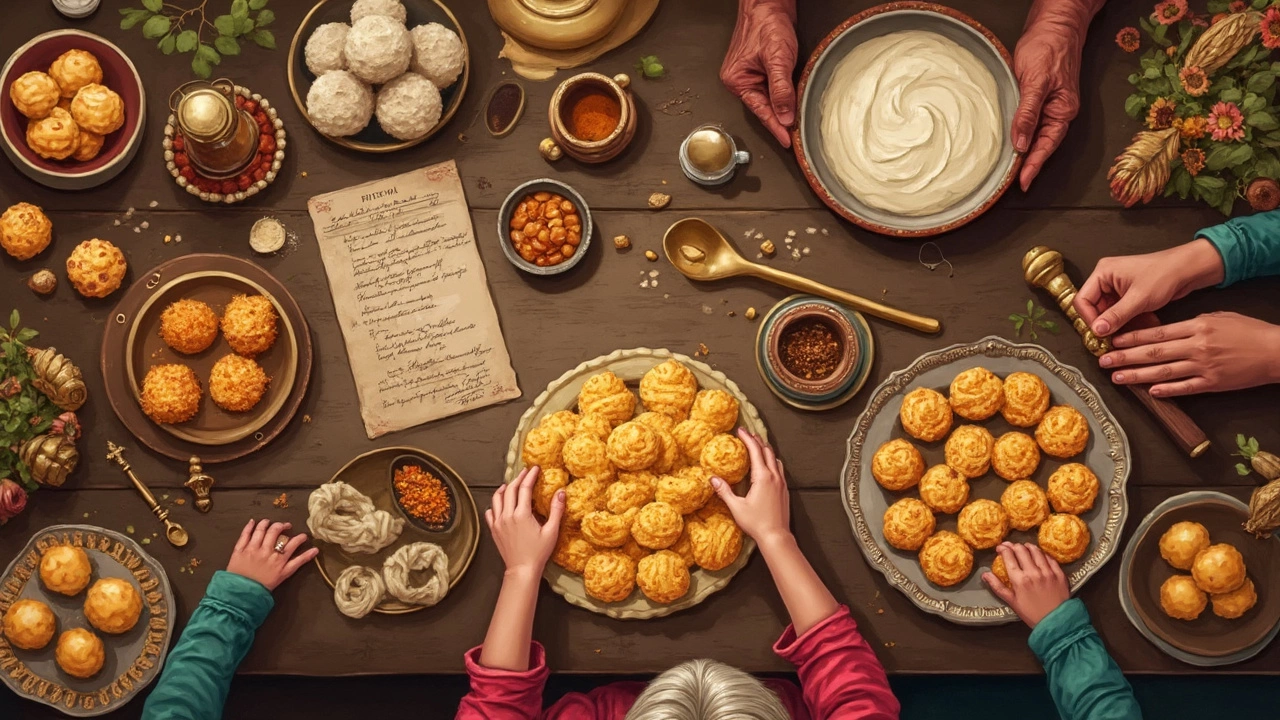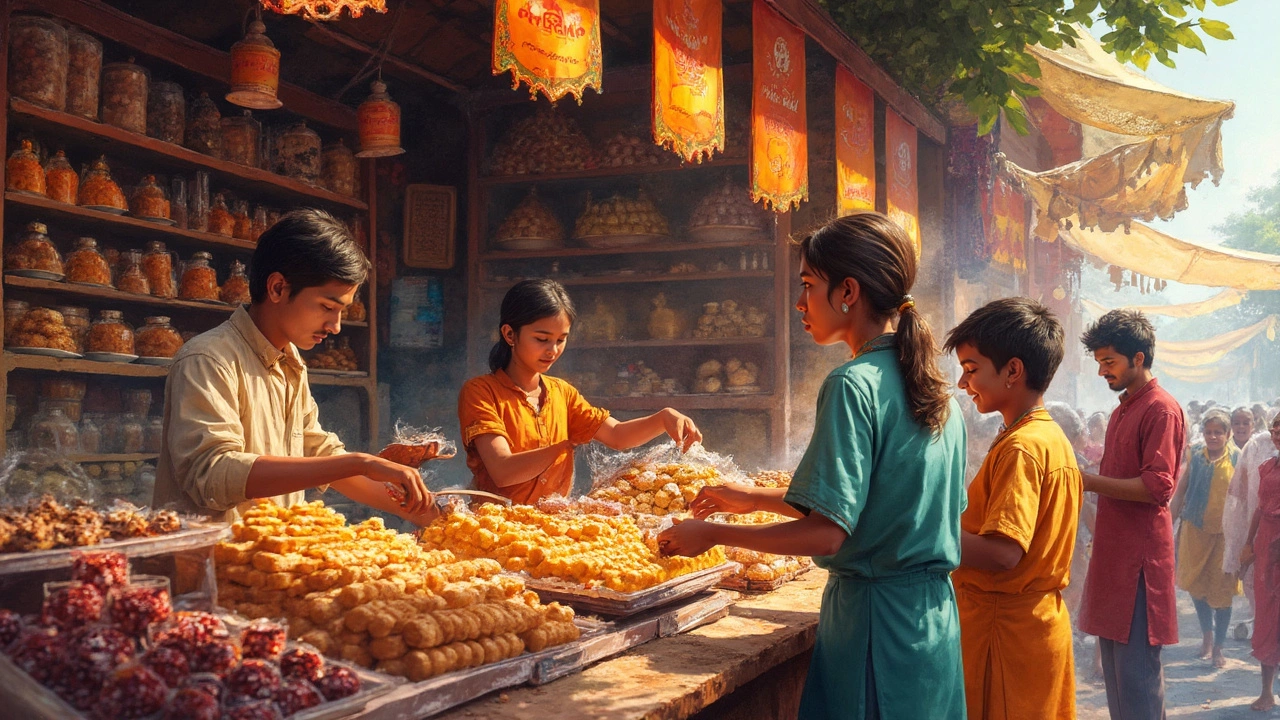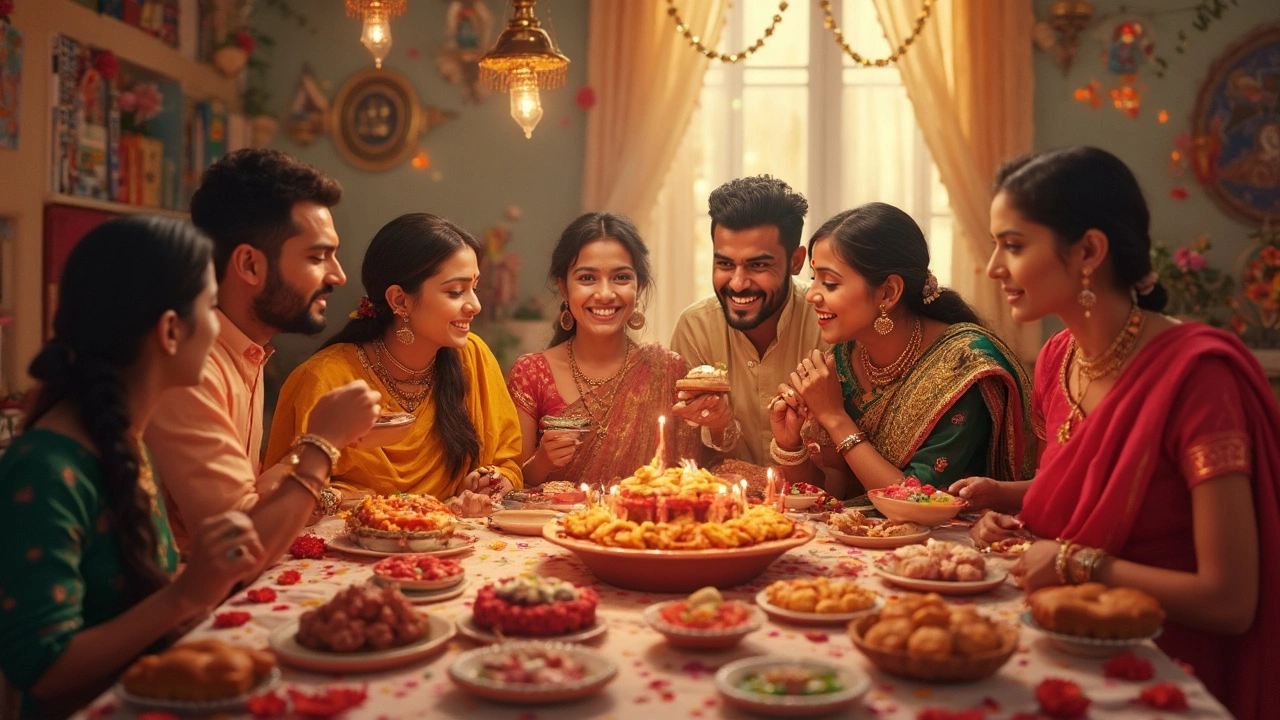Try asking a hundred people, “What’s the tastiest thing in India?” Odds are, you’ll get a hundred passionate answers, and almost all of them will revolve around sweets. In India, sweets don’t just end a meal—they mark every celebration, every milestone, and sometimes, just plain old Tuesdays. If you’ve ever found yourself confused by words like barfi, rasgulla, or jalebi, you’re not alone.
Here’s something wild—India has thousands of distinct kinds of sweets. They’re not all super sugary, and some barely use sugar at all. The main thing? Each one packs in tradition, regional flavor, and a ton of nostalgia for anyone who grew up with them. In this article, you’ll get a no-nonsense breakdown of what makes these treats stand out (trust me, it’s not just the sugar rush). You’ll pick up tips for spotting a great mithai shop, learn quick tricks to make sweets at home, and get the inside scoop on which desserts Indians fight over at family weddings.
- What Makes Indian Sweets Unique?
- The Big Names: India’s Most Famous Sweets
- Regional Favorites That Deserve the Spotlight
- Tips for Making Indian Sweets at Home
- Choosing Your Tastiest Sweet
What Makes Indian Sweets Unique?
What really sets Indian sweets apart from other desserts isn’t just their flavor or the amount of sugar—they’re all about top-notch ingredients, a wild variety of cooking styles, and the creative use of milk and nuts. In most Indian kitchens, sweets aren’t just whipped up for cravings. They celebrate life’s wins: a birthday, a new job, even a neighbor dropping by unannounced.
The secret sauce? Milk. Nearly every classic sweet uses milk in one form or another. You’ll find khoya (which is just milk boiled down till thick), paneer (fresh cheese), or condensed milk popping up in recipes everywhere. The texture you get from these ingredients is like nothing else—think squishy-soft, chewy, or melt-in-your-mouth.
It gets better. India is picky about spices. Cardamom, saffron, and even black pepper get thrown into sweets, sometimes with rose water or kewra for a hint of perfume. This isn’t just to show off—it changes the way you taste sugar, making even the simplest sweet layer up with flavor instead of just tasting one-note and cloying.
If you’re comparing Indian sweets with Western desserts, notice this: Indian sweets don’t just use sugar for sweetness. They use jaggery, honey, or even fruit reduction, depending on region and what’s available. This makes for a spectrum of flavors from almost syrupy to deep and smoky.
Here’s a reality check. India’s sweets are shaped by geography: some bite-sized, dunked in syrup (like rasgulla from Bengal), some baked, some fried until crispy (hello, jalebi). Every region gets creative with what it has.
- Freshness matters: Most Indian sweets taste best when eaten within a day or two. That’s why street shops crank out batch after batch daily.
- Nuts and dried fruits: Cashews, pistachios, and almonds often top or stuff sweets for extra crunch and richness.
- No eggs, no problem: You almost never see eggs in Indian sweets, making them a sweet fix for vegetarians.
To give you a peek into the sheer variety, here’s a quick breakdown:
| Type | Main Ingredient | Region Famous For It |
|---|---|---|
| Ladoo | Chickpea Flour | North India |
| Rasgulla | Paneer | East (Bengal) |
| Mysore Pak | Besan & Ghee | South (Karnataka) |
| Peda | Khoya | Central/West |
| Jalebi | Refined Flour & Sugar Syrup | All Over |
What’s wild is, every family has its own way of making these. You might visit two houses in the same street and both will swear their recipe is the ‘real deal.’ That’s the beauty of Indian sweets: tradition meets innovation, every single day.
The Big Names: India’s Most Famous Sweets
When you talk about Indian sweets, a few heavy hitters always get name-checked. Walk into an Indian sweet shop (called a mithaiwala), and you’ll see trays stacked with these. Some have been around for centuries, and every region swears their version is the best.
Here are the ones you see all over India:
- Gulab Jamun: Small, melt-in-the-mouth balls made from khoya (a thickened milk), fried, then soaked in sugar syrup. They’re a party staple. Surveys show Gulab Jamun is the top choice in North India for festivals and family functions.
- Jalebi: Spirals of fermented batter fried till they’re crunchy, then dunked in saffron-flavored syrup. This is breakfast material in many places, eaten hot with milk or curd.
- Rasgulla: These soft cheese balls in light syrup hail from Bengal and Odisha, and both states claim they invented it. In 2017, West Bengal even got a geographical indication (GI) tag for their version, so the rivalry is real.
- Barfi: Think of these as Indian fudge squares, usually made from milk, flavored with cardamom, and topped with nuts or edible silver leaf. There are dozens of types—kaju barfi (cashew), pista barfi (pistachio), and more.
- Ladoo: Round and ready for any festive moment. They can be made with gram flour (besan), semolina (sooji), coconut, or even crushed wheat. Modak, a kind of ladoo from Maharashtra, is Lord Ganesha’s favorite—if you believe what every grandma says.
Here’s a quick peek at how these sweets compare when it comes to popularity and celebratory uses:
| Sweett | Main Occasion | Main Ingredient |
|---|---|---|
| Gulab Jamun | Weddings, Diwali | Khoya (Reduced milk) |
| Jalebi | Breakfast, Holi | Maida (Refined flour) |
| Rasgulla | Durga Puja, birthdays | Chhena (curdled milk) |
| Barfi | Diwali, gift boxes | Milk solids, nuts |
| Ladoo | Ganesh Chaturthi, exams | Gram flour/coconut/wheat |
And here’s a quick tip—if you walk into any sweet shop and see these still glistening in syrup or dusted with nuts, they’re likely fresh. Never take home sweets looking dry around the edges. For beginners eager to make Indian desserts at home, these five are a great place to start. There are countless YouTube videos and step-by-step guides online to follow along.

Regional Favorites That Deserve the Spotlight
Everyone talks about gulab jamun and jalebi, but step away from the usual suspects and every state in India has its own sweet star. Some of these treats are known only in one city or even a neighborhood, but locals swear they're the tastiest Indian food you’ll ever try.
If you’re in Bengal, you’ll meet sandesh—not as gooey as rasgulla, but light, creamy, and loaded with fresh cottage cheese (chhena). Sandesh isn’t just sweet; people like to infuse it with local mango, pistachio, or even date molasses for serious flavor twists.
Head west, and Gujarat brings you mohanthal. This fudge-like bite gets its magic from roasted gram flour and ghee. Don’t be fooled by its simple look: mohanthal is dense, rich, and melts the minute you bite in. Around festive times, you’ll find entire families making huge batches to share with neighbors.
Go down south, and you can’t skip Mysore pak from Karnataka. It’s one of the most famous Indian sweets for a reason—loads of ghee, sugar, and just the right amount of roasted chickpea flour. Mysore pak comes in two main versions: one super soft and chewy, and one a bit crumbly. The soft one literally dissolves after you pop it in your mouth.
Maharashtra has modak, a steamed dumpling stuffed with coconut and jaggery. This sweet is so special there’s even a festival (Ganesh Chaturthi) where people make thousands of these for good luck.
Here’s a quick look at some regional Indian sweets and where you’ll find them:
- Sandesh – West Bengal
- Mysore Pak – Karnataka
- Modak – Maharashtra
- Mohanthal – Gujarat
- Pinni – Punjab (made with wheat flour, ghee, nuts—perfect for winter!)
One wild fact: According to a 2023 regional food survey, 74% of Indians said their all-time favorite sweet is connected to their home state. That’s how deep these local treats run.
If you’re traveling or want to try your hand at Indian desserts at home, watch for these regional hits—they tell a richer story than the usual bites you see at big city sweet shops.
Tips for Making Indian Sweets at Home
Jumping into homemade Indian sweets can seem tough, but you don’t need any pro skills or fancy gear to get started. If you follow a few practical tips, even mithai newbies can nail classics like gulab jamun or kaju katli.
- Start simple: Begin with sweets that keep mistakes to a minimum. Coconut laddoo, rice kheer, and suji halwa don’t ask for a bunch of steps or special equipment. Perfect these before you try complicated stuff like rasgulla or jalebi.
- Ingredients matter: Don’t cheap out on basics. Always use fresh milk, good quality ghee, and fresh nuts. Canned condensed milk is a lifesaver for rich, creamy sweets—it cuts both time and mess.
- Measure, don’t guess: Unlike dal or curry, most desserts need you to be exact. Too much or too little sugar, and that perfect batch is toast. Weigh out ingredients or use proper cups and spoons.
- Low and slow: Many sweets need slow cooking. Don’t rush. If the recipe says to simmer, keep that heat low even if you’re in a hurry. Rushed rabdi or kheer ends up burnt, sticky, or both.
- Practice patience: A lot of Indian desserts taste best after sitting a while. Allow your barfi or peda to cool fully—they’ll set up better and taste richer.
It helps to keep these common kitchen tools handy:
- Nonstick pan (makes cleaning up milk-based sweets way easier)
- Fine strainer (for getting cardamom pods or stray threads out of syrups)
- A digital timer (so you never overboil milk again)
Want to avoid the most common mistakes? Burnt sugar syrup can kill a batch of jalebi. Always keep an eye on your pan and stir often. If you’re making syrup, use a candy thermometer if you have one—a one degree difference makes rasgullas chewy instead of soft. Here’s a handy table for sugar syrups used in Indian sweets:
| Syrup Stage | Temp (°C) | Used In |
|---|---|---|
| One string | 105–110 | Barfi, peda |
| Two string | 110–115 | Jalebi, imarti |
Don't stress over getting it perfect your first time—most grandmas tweak things by taste anyway! Once you find a sweet you like making, stick with it a few more times. You’ll get the hang of the techniques and it’ll feel easier every round.

Choosing Your Tastiest Sweet
Picking the best out of all Indian sweets can feel impossible, but it actually gets a lot easier if you narrow things down by flavor, region, or even the mood you’re in. India’s sweets can be milky, nutty, syrupy, dry, or even tangy. A smart tip? Some of the biggest names—like gulab jamun or barfi—are great starter sweets, but lots of people end up loving the lesser-known treats even more once they try them.
If you feel stuck, these quick filters can help you zero in on your perfect bite:
- Texture: If you like soft and juicy, try rasgulla or gulab jamun. Craving something crunchy? Go for soan papdi or chikki.
- Flavor profile: If you prefer your desserts rich and milky, nothing beats classic barfi or pedha. Want something extra sweet and syrupy? Jalebi wins every time. If you hate super sweet stuff, try sandesh from Bengal—it’s mild and all about the subtle flavors.
- Regional loves: North Indian sweets tend to be dairy-heavy, South Indian ones often use coconut and rice flour, and East Indian sweets focus on chhena (a fresh, soft cheese).
- Diet restrictions: Plenty of Indian desserts are naturally gluten-free, and a few, like kaju katli, even fit vegan diets if made without ghee.
Ever wonder which desserts Indians buy the most? Here’s a quick snapshot based on sales at major Indian sweet shops in 2023:
| SWEET | Popularity (% of sales) |
|---|---|
| Gulab Jamun | 22% |
| Jalebi | 18% |
| Barfi (all types) | 16% |
| Rasgulla | 12% |
| Kaju Katli | 10% |
If you’re unsure where to begin, head for the classics first—there’s a reason they’ve survived generations of changing taste buds. But don’t be afraid to wander into local sweet shops and ask for what’s unique to the city or village. That’s often how you stumble on hidden gems.
One last insider tip: Indian sweets taste different depending on whether you get them fresh, from a famous place, or homemade. Most Indians swear that homemade wins every time, but sampling from a legendary sweet shop like Haldiram’s or a local favorite is an experience you won’t forget.
